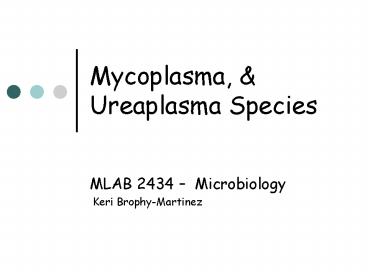Mycoplasma, - PowerPoint PPT Presentation
1 / 8
Title:
Mycoplasma,
Description:
Mycoplasma, & Ureaplasma Species MLAB 2434 Microbiology Keri Brophy-Martinez Mycoplasma and Ureaplasma Species General Characteristics Once thought to be viruses ... – PowerPoint PPT presentation
Number of Views:181
Avg rating:3.0/5.0
Title: Mycoplasma,
1
Mycoplasma, Ureaplasma Species
- MLAB 2434 Microbiology
- Keri Brophy-Martinez
2
Mycoplasma and Ureaplasma Species
- General Characteristics
- Once thought to be viruses because of size
- Mycoplasmas are the smallest free-living organism
in nature - Four human pathogens
- Mycoplasma pneumoniae - respiratory
- Mycoplasma hominis - urogenital
- Ureaplasma urealyticum urogenital
- Ureaplasma parvum- urogenital
3
Mycoplasma and Ureaplasma Species (contd)
- Lack a cell wall
- Pleomorphic organisms
- Resistant to cell-wall-active antibiotics)
- Susceptible to heat and drying
- Slow growing, highly fastidious, facultative
anaerobes - Require complex media for growth
4
Mycoplasma and Ureaplasma Species (contd)
- Pathogens of respiratory and urogenital tracts
- Transmission
- Direct sexual contact
- Mother-child exposure during delivery or in utero
- Respiratory secretions/aerosols
- Nosocomial (transplanted tissues)
5
Clinical Infections
- Mycoplasma pneumoniae
- Causes bronchitis, pharyngitis, or primary
atypical pneumonia (a.k.a. walking pneumonia) - Usually infects school-age children and young
adults in close quarters (dorms, military
barracks, etc.) - 50 of infections produce cold agglutinins
- Most often diagnosed by serologic evaluation and/
or PCR
6
M. hominis Ureaplasma species
- Most often associated with urogenital tract
infections - May be isolated from asymptomatic individuals
- Can be transmitted to the fetus at delivery
- Opportunistic pathogens
7
Laboratory Diagnosis
- Cultures must be delivered immediately to the
lab, because the organisms are very susceptible
to drying - Should be placed in transport media
- Swabs should be of Dacron, polyester or calcium
alginate with a plastic or aluminum shaft - If not plated immediately, should be frozen at
-70C - Most infections detected via serologic evaluation
or PCR
8
References
- Kiser, K. M., Payne, W. C., Taff, T. A. (2011).
Clinical Laboratory Microbiology A Practical
Approach . Upper Saddle River, NJ Pearson
Education. - Mahon, C. R., Lehman, D. C., Manuselis, G.
(2011). Textbook of Diagnostic Microbiology (4th
ed.). Maryland Heights, MO Saunders.































